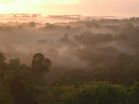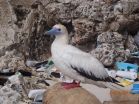INFORMATION:
Team harnesses intense X-ray beam, observes unusual phenomenon for the first time
Findings may lead to novel new ways to diagnose matter in the future
2015-08-31
(Press-News.org) Lincoln, Neb., Aug. 31, 2015 -- Using an enormous X-ray laser -- one of only two such machines on Earth -- University of Nebraska-Lincoln physicist Matthias Fuchs and scientists from around the world beat formidable odds to observe one of the most fundamental interactions between X-rays and matter.
The findings can aid future studies and may lead to novel new ways to diagnose matter in the future.
Fuchs and his colleagues induced two X-ray photons to simultaneously collide with a single atom, which converts them into a single higher-energetic X-ray photon. It's a phenomenon that doesn't occur under normal circumstances, and the results of the first-ever experiment were published Monday in the journal Nature Physics.
Fuchs, an assistant professor of physics and astronomy, is the article's lead author. Others involved are from the Stanford Linear Accelerator Center, Stanford University and Bar-Ilan University in Israel.
"The experiment was the very first investigation of this kind, which means that we were entering what you would call 'Neuland' (German for uncharted territory)," Fuchs said.
Scientists first observed a similar process involving high-intensity visible light in the 1960s, resulting in a technology used in most laser laboratories and even with many laser pointers available to consumers. However, it had not been possible until recently to observe such interactions at X-ray wavelengths because there was no X-ray source that could produce X-rays of sufficient intensity.
Because they have a small wavelength that allows scientists to resolve matter down to the size of its constituent atoms, X-rays are routinely used to take a "deep look" into matter, Fuchs said. The double-helix structure of DNA was one of the most famous discoveries using X-rays. The field of X-rays has generated at least 15 Nobel Prizes and as many as 28, if discoveries that indirectly use X-rays are counted.
Fuchs and other team members used a new source of X-rays, an X-ray free-electron laser at the National Accelerator Laboratory in California, to conduct experiments. Measuring more than a kilometer in length, the only other machine like it is in Japan.
Focusing the machine's full output into a spot of only 100 nanometers in size, the team generated an X-ray beam with intensity equivalent to all of the sun's radiation that is striking the Earth's surface but concentrated in an area with the diameter of a human hair.
"We needed such extreme intensities to improve the chances of both of the two photons meeting up at exactly the right place and exactly the right time on one of the many atoms that were illuminated," Fuchs said. "Even so, the probability that this nonlinear interaction occurs on any given atom is less than winning the lottery."
The scientists found some unexpected results, however. The energy of the converted photons was much lower than expected, indicating that the physics of the interaction may be richer and more interesting than anticipated.
One scientist who anonymously reviewed the research said that when the phenomenon becomes better understood, it will become a part of textbooks on X-ray physics and nonlinear optics.
"This experiment is just beginning," Fuchs said. "If our new understanding of this fundamental process can be confirmed by future experiments, it can have significant impact on future experiments that are performed with high X-ray intensities and can lead to novel diagnostic methods of matter."
ELSE PRESS RELEASES FROM THIS DATE:
Columbia engineers develop new approach to modeling Amazon seasonal cycles
2015-08-31
New York, NY--August 31, 2015--With the rise of CO2 in Earth's atmosphere, understanding the climate of tropical forests--the Amazon in particular--has become a critical research area. A recent NASA study showed that these regions are the biggest terrestrial carbon dioxide sinks on our planet, absorbing 1.4 billion metric tons of CO2 out of a total global terrestrial absorption of 2.5 billion. To simulate the tropical climate to learn more about its processes, climate scientists have typically been relying on general circulation models (GCMs) to simulate the tropical climate. ...
Sea temperature changes linked to mystery North Pacific ecosystem shifts
2015-08-31
Longer, less frequent climate fluctuations may be contributing to abrupt and unexplained ecosystem shifts in the North Pacific, according to a study by the University of Exeter.
Researchers have long been puzzled by two rapid and widespread changes in the abundance and distribution of North Pacific plankton and fish species that impacted the region's economically important salmon fisheries. In 1977, and again in 1989, the number of salmon in some areas plummeted, while it increased in other areas. These events have been dubbed regime shifts by researchers.
Now, in ...
Short sleepers are 4 times more likely to catch a cold
2015-08-31
A new study led by a UC San Francisco sleep researcher supports what parents have been saying for centuries: to avoid getting sick, be sure to get enough sleep.
The team, which included researchers at Carnegie Mellon University and University of Pittsburgh Medical Center, found that people who sleep six hours a night or less are four times more likely to catch a cold when exposed to the virus, compared to those who spend more than seven hours a night in slumber land.
This is the first study to use objective sleep measures to connect people's natural sleep habits and ...
New type of prion may cause, transmit neurodegeneration
2015-08-31
Multiple System Atrophy (MSA), a neurodegenerative disorder with similarities to Parkinson's disease, is caused by a newly discovered type of prion, akin to the misfolded proteins involved in incurable progressive brain diseases such Creutzfeldt-Jakob Disease (CJD), according to two new research papers led by scientists at UC San Francisco.
The findings suggest new approaches to developing treatments for MSA, which currently has no cure, but also raise a potential concern for clinicians or scientists who come in contact with MSA tissue.
The new findings mark the first ...
New research confirms lack of sleep connected to getting sick
2015-08-31
Scientists have long associated sufficient sleep with good health. Now they've confirmed it.
In 2009, Carnegie Mellon University's Sheldon Cohen found for the first time that insufficient sleep is associated with a greater likelihood of catching a cold. To do this, Cohen, who has spent years exploring psychological factors contributing to illness, assessed participants self-reported sleep duration and efficiency levels and then exposed them to a common cold virus.
Now, Cohen, the Robert E. Doherty University Professor of Psychology in the Dietrich College of Humanities ...
Plastic in 99 percent of seabirds by 2050
2015-08-31
Researchers from CSIRO and Imperial College London have assessed how widespread the threat of plastic is for the world's seabirds, including albatrosses, shearwaters and penguins, and found the majority of seabird species have plastic in their gut.
The study, led by Dr Chris Wilcox with co-authors Dr Denise Hardesty and Dr Erik van Sebille and published today in the journal PNAS, found that nearly 60 per cent of all seabird species have plastic in their gut.
Based on analysis of published studies since the early 1960s, the researchers found that plastic is increasingly ...
Single mothers much more likely to live in poverty than single fathers, study finds
2015-08-31
URBANA, Ill. - Single mothers earn significantly less than single fathers, and they're penalized for each additional child they have even though the income of single fathers remains the same or increases with each added child in their family. Men also make more for every additional year they invest in education, further widening the gender gap, reports a University of Illinois study.
"Single mothers earn about two-thirds of what single fathers earn. Even when we control for such variables as occupation, numbers of hours worked, education, and social capital, the income ...
Study reveals human body has gone through four stages of evolution
2015-08-31
BINGHAMTON, NY - Research into 430,000-year-old fossils collected in northern Spain found that the evolution of the human body's size and shape has gone through four main stages, according to a paper published this week.
A large international research team including Binghamton University anthropologist Rolf Quam studied the body size and shape in the human fossil collection from the site of the Sima de los Huesos in the Sierra de Atapuerca in northern Spain. Dated to around 430,000 years ago, this site preserves the largest collection of human fossils found to date anywhere ...
Older people getting smarter, but not fitter
2015-08-31
Older populations are scoring better on cognitive tests than people of the same age did in the past --a trend that could be linked to higher education rates and increased use of technology in our daily lives, say IIASA population researchers.
People over age 50 are scoring increasingly better on tests of cognitive function, according to a new study published in the journal PLOS ONE. At the same time, however, the study showed that average physical health of the older population has declined.
The study relied on representative survey data from Germany which measured cognitive ...
Gene leads to nearsightedness when kids read
2015-08-31
NEW YORK, NY (August 31, 2015) -- Vision researchers at Columbia University Medical Center have discovered a gene that causes myopia, but only in people who spend a lot of time in childhood reading or doing other "nearwork."
Using a database of approximately 14,000 people, the researchers found that those with a certain variant of the gene - called APLP2 - were five times more likely to develop myopia in their teens if they had read an hour or more each day in their childhood. Those who carried the APLP2 risk variant but spent less time reading had no additional risk ...
LAST 30 PRESS RELEASES:
Making lighter work of calculating fluid and heat flow
Normalizing blood sugar can halve heart attack risk
Lowering blood sugar cuts heart attack risk in people with prediabetes
Study links genetic variants to risk of blinding eye disease in premature infants
Non-opioid ‘pain sponge’ therapy halts cartilage degeneration and relieves chronic pain
AI can pick up cultural values by mimicking how kids learn
China’s ecological redlines offer fast track to 30 x 30 global conservation goal
Invisible indoor threats: emerging household contaminants and their growing risks to human health
Adding antibody treatment to chemo boosts outcomes for children with rare cancer
Germline pathogenic variants among women without a history of breast cancer
Tanning beds triple melanoma risk, potentially causing broad DNA damage
Unique bond identified as key to viral infection speed
Indoor tanning makes youthful skin much older on a genetic level
Mouse model sheds new light on the causes and potential solutions to human GI problems linked to muscular dystrophy
The Journal of Nuclear Medicine ahead-of-print tip sheet: December 12, 2025
Smarter tools for peering into the microscopic world
Applications open for funding to conduct research in the Kinsey Institute archives
Global measure underestimates the severity of food insecurity
Child survivors of critical illness are missing out on timely follow up care
Risk-based vs annual breast cancer screening / the WISDOM randomized clinical trial
University of Toronto launches Electric Vehicle Innovation Ontario to accelerate advanced EV technologies and build Canada’s innovation advantage
Early relapse predicts poor outcomes in aggressive blood cancer
American College of Lifestyle Medicine applauds two CMS models aligned with lifestyle medicine practice and reimbursement
Clinical trial finds cannabis use not a barrier to quitting nicotine vaping
Supplemental nutrition assistance program policies and food insecurity
Switching immune cells to “night mode” could limit damage after a heart attack, study suggests
URI-based Global RIghts Project report spotlights continued troubling trends in worldwide inhumane treatment
Neutrophils are less aggressive at night, explaining why nighttime heart attacks cause less damage than daytime events
Menopausal hormone therapy may not pose breast cancer risk for women with BRCA mutations
Mobile health tool may improve quality of life for adolescent and young adult breast cancer survivors
[Press-News.org] Team harnesses intense X-ray beam, observes unusual phenomenon for the first timeFindings may lead to novel new ways to diagnose matter in the future


